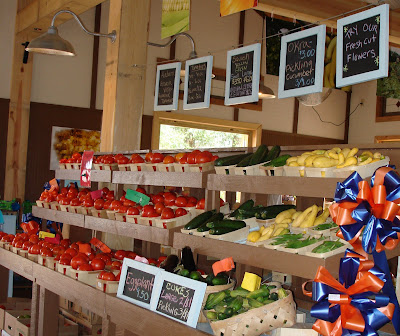
That really is the question. After reading Barbara Kingsolver's book Animal, Vegetable, Miracle, which is as entertaining as it is informative, I have been plagued by one more aspect of my eating habits. For those of you who don't know the premise behind the book, Kingsolver and her family left their home in California to return to the family farm in the South with a resolve to eat only locally. The family agreed that each person could have one non-local food item (I agree with the selection of coffee and bananas!), and all other foods would come from their garden/homestead or the local farmers market. They began with vegetables but expanded their project to include turkeys, chickens, and beef, as I recall. It was an effort of love, research, patience, and experimentation, all of which Kingsolver chronicles in her book. I would give more specifics, but I think I lent the book to someone (I'm getting more careless/carefree in my lending habits).
We have friends in British Columbia who are growing and buying as much as they can, if not all, of their food locally, but what of the rest of us who don't live on a farm or in a bountiful agricultural area or in an area that supports favorite foods? For example, I love asparagus but am not a huge fan of collard greens. Unfortunately, sources abound for collard greens, but there doesn't seem to be a local source for asparagus even though it can be grown in the South. Instead, we usually have to choose asparagus from Peru or Mexico or some other locale thousands of miles away--so we choose not to buy asparagus except on special occasions. If our experimentation goes well this year, we may plant asparagus next year and wait three years for the first harvest.
I'm sure some people dismiss the idea of eating only locally because it is so difficult to eat 100 percent local fare. Even Earth Fare's idea of local is produce from North Carolina, and they violate the local premise by importing some of their red peppers from Israel and some of their beef from Australia. There are times I must decide if it's more responsible to buy from Mexico or California. In part, that is why we decided to expand our gardening efforts this year.
Anthony and I don't begin to pretend that we eat 100 percent local food, but we do try to be as local as possible. Blooming Colors, which is where I took the above photo a couple of years ago, has a market place offering wonderful, fresh goat cheese from a local farm (in Tallapoosa County, I think) and vegetables from Auburn and the surrounding area. Not everything is local, but quite a few items are. We also participate in Randle Farms CSA (Community Supported Agriculture) and purchase 98 percent of our meat, most of our eggs, and some vegetables and fruit from them. The Randles grow their food using sustainable, organic practices. They offer half shares of meat and you can split a vegetable share with a friend as we did this season. Email them for details if you're interested.
Why eat local? Some say that it saves on fossil fuels, though I found a site on the web that disagrees with that premise. Everyone, I think, could agree that local food tastes better than food shipped from, say, Peru. I know that our decision to eat more locally and grow what we can is based in part on trying to save fossil fuels and having fresher food, but it's also about supporting local, small businesses and farms, and loosening the grip of giant corporations on our food supply. We don't like the practices of international corporations and their increasing control over the food supply. Every little bit an individual does helps, or so I like to think.
If you're interested in starting your own local, food-growing "experiment," you're just in time. The season is right and resources are a key stroke away. I started my planning phase with a book by Rosalined Creasy titled Edible Landscaping. The National Gardening Association has a website with tips, as does Mother Earth News and universities and extension services, including ACES. The good news is you don't need a lot of space in one area because you can spread plantings throughout your front and back yard where the light best fits your growing needs. If you live in an apartment, you can try a method called vertical gardening.
So, get gardening! It's therapeutic as well as delicious!
No comments:
Post a Comment